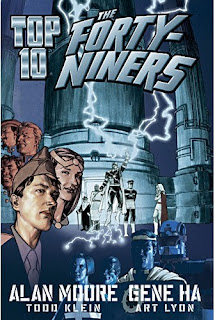The Dark Country by Dennis Etchison, containing the following stories: "It Only Comes Out at Night", "Sitting in the Corner, Whimpering Quietly", "The Walking Man", "We Have All Been Here Before", "Daughter of the Golden West", "The Pitch", "You Can Go Now", "Today's Special", "The Machine Demands a Sacrifice", "Calling All Monsters", "The Dead Line", "The Late Shift", "The Nighthawk", "It Will Be Here Soon", "Deathtracks", and "The Dark Country." (1972-1982; Collected 1982):
It took nearly 20 years of being published before Dennis Etchison got his first collection of short stories. It's a dandy, collecting the best of his work from the 1970's and early 1980's.
Etchison's idiosyncratic style and subject matter are in full view here, from the near-future horrors of the "Transplant trilogy" ("The Machine Demands a Sacrifice", "Calling All Monsters", "The Dead Line"), in which the demand for organ donors has ventured into Pythonesque territory, to The Hardy Boys Goe To Hell weirdness of "Daughter of the Golden West."
The award-winning title novella is perhaps the weirdest story here, a subtle horror story about a bad Mexican vacation in which the horrors never completely manifest themselves. It's like a vignette from Apocalypse Now by way of Spring Break. There's also blatant, bloody revenge fantasy suggestive of EC horror comics in "The Pitch" and "Today's Special" and "We Have All Been Here Before."
Two of Etchison's major tropes -- Southern California and "the road" -- appear again and again here, sometimes in concert (the Los Angeles area has a lot of cars and a lot of drivers, after all). Everyone seems to be in transit; everyone is the target of sinister but often undefined horrors that can come from anywhere, anytime. The seemingly ordinary -- late-night convenience-store clerks, highway rest stops, tow trucks, even television laugh tracks -- shimmer with hidden menace, sometimes fatally revealed. Some things come out of the dark; some things hunt in the sun. Highly recommended.
Etchison's idiosyncratic style and subject matter are in full view here, from the near-future horrors of the "Transplant trilogy" ("The Machine Demands a Sacrifice", "Calling All Monsters", "The Dead Line"), in which the demand for organ donors has ventured into Pythonesque territory, to The Hardy Boys Goe To Hell weirdness of "Daughter of the Golden West."
The award-winning title novella is perhaps the weirdest story here, a subtle horror story about a bad Mexican vacation in which the horrors never completely manifest themselves. It's like a vignette from Apocalypse Now by way of Spring Break. There's also blatant, bloody revenge fantasy suggestive of EC horror comics in "The Pitch" and "Today's Special" and "We Have All Been Here Before."
Two of Etchison's major tropes -- Southern California and "the road" -- appear again and again here, sometimes in concert (the Los Angeles area has a lot of cars and a lot of drivers, after all). Everyone seems to be in transit; everyone is the target of sinister but often undefined horrors that can come from anywhere, anytime. The seemingly ordinary -- late-night convenience-store clerks, highway rest stops, tow trucks, even television laugh tracks -- shimmer with hidden menace, sometimes fatally revealed. Some things come out of the dark; some things hunt in the sun. Highly recommended.





















